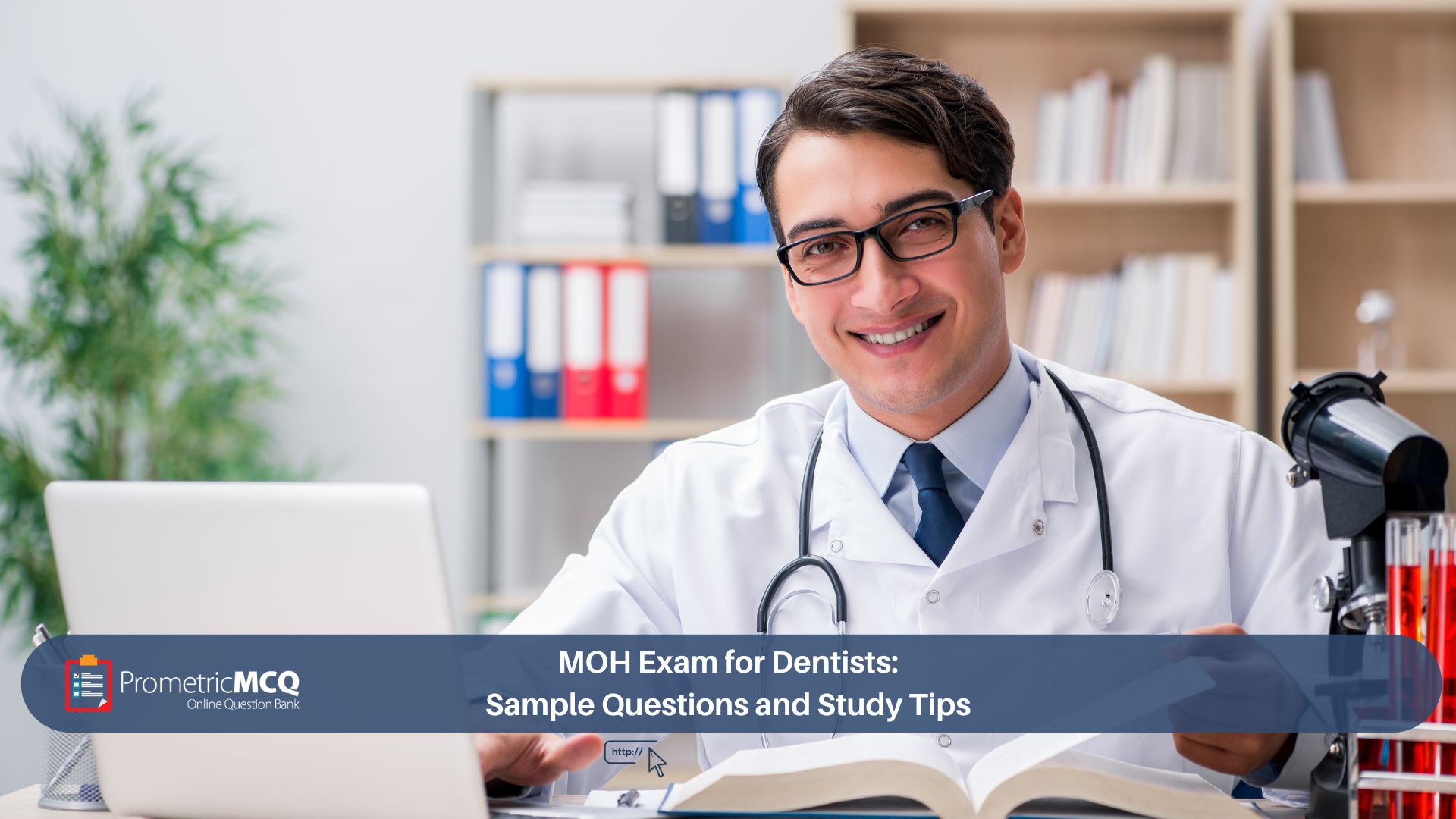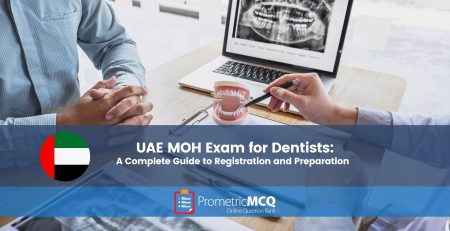
MOH Exam for Dentists: Sample Questions and Study Tips
fatima@prometricmcq.com2025-09-17T14:15:15+00:00Table of Contents
ToggleMOH Exam for Dentists: Sample Questions and Study Tips (2025)
For dental professionals seeking a rewarding career in the United Arab Emirates, the Northern Emirates—Sharjah, Ajman, Umm Al-Quwain, Ras Al-Khaimah, and Fujairah—offer a landscape of immense growth and opportunity. The key to unlocking a professional license in these regions is the Ministry of Health and Prevention (MOHAP) exam for dentists. This is not merely a test of academic recall; it is a rigorous, case-based assessment of your clinical judgment, diagnostic skills, and ability to formulate safe and effective treatment plans.
The most proven path to success on this high-stakes exam is not just studying, but strategic preparation centered around realistic practice questions. Engaging with exam-style Multiple-Choice Questions (MCQs) is the best way to understand the test’s format, identify high-yield clinical topics, and sharpen the critical thinking required to navigate complex dental scenarios. As our complete guide to the UAE MOH exam for dentists explains, a structured approach is essential.
This ultimate guide serves as your comprehensive resource, providing a wealth of free MOH exam sample questions, each with a detailed, explanatory rationale. We will also delve into expert study tips and a strategic framework to guide your preparation. Our objective is to equip you with the knowledge, skills, and confidence to not just attempt the exam, but to pass it on your first try, paving the way for a successful dental career in the UAE.
Key Takeaways for MOH Dental Exam Success
- Diagnosis and Treatment Planning are Core: The majority of questions are clinical vignettes that require you to arrive at a diagnosis and select the most appropriate treatment.
- Master the Basics: A deep understanding of oral pathology, pharmacology, and dental materials is non-negotiable and will be tested in various clinical contexts.
- Radiographic Interpretation is a Must: Be proficient in reading periapical radiographs, bitewings, and OPGs to identify caries, periapical lesions, bone loss, and common pathologies.
- Medical Emergencies are High-Yield: Know how to recognize and provide initial management for common medical emergencies in a dental clinic, such as syncope, hypoglycemia, and anaphylaxis.
- Practice is Paramount: There is no substitute for working through a large volume of high-quality MCQs to master the exam’s style and content.
Deconstructing the 2025 MOH Dental Exam Blueprint
A strategic approach begins with knowing the exam’s structure and content areas. The MOHAP exam for General Dentists is a Computer-Based Test (CBT) designed to assess the competency of an entry-level practitioner. It typically comprises 150 MCQs to be answered in 165 minutes.
| Core Dental Domain | High-Yield Topics and Concepts |
|---|---|
| Operative & Restorative Dentistry | Principles of cavity preparation (G.V. Black), caries diagnosis, properties and manipulation of dental materials (amalgam, composites, glass ionomers, bonding agents), and management of deep carious lesions (pulp capping). |
| Endodontics | Diagnosis of pulpal and periapical pathology, root canal treatment procedures, management of traumatic dental injuries (e.g., avulsion, luxation), and knowledge of endodontic materials. |
| Prosthodontics | Principles of fixed prosthodontics (crown and bridge), complete and removable partial denture design and troubleshooting, impression materials, and foundational concepts of implant dentistry. |
| Oral Surgery & Anesthesia | Routine and surgical extractions, management of impacted third molars, pharmacology of local anesthetics and vasoconstrictors, local anesthetic techniques and complications, and management of post-operative complications (e.g., dry socket). |
| Periodontics | Diagnosis and classification of periodontal and gingival diseases, non-surgical and surgical periodontal therapy, understanding the link between periodontal and systemic health, and management of periodontal emergencies. |
| Pediatric Dentistry (Pedodontics) | Caries management in primary teeth, pulp therapy for primary teeth (pulpotomy), space maintenance, and behavioral management techniques. |
| Oral Pathology, Medicine & Radiology | Diagnosis of common oral mucosal lesions (aphthous ulcers, lichen planus, candidiasis), radiographic interpretation of cysts and tumors, and oral manifestations of systemic diseases. |
Approach every practice question as if it’s a patient in your chair. Read the history, analyze the clinical findings, study the radiograph, and only then formulate your differential diagnosis and treatment plan. This mindset is key.
Free MOH Dental Exam Sample Questions & In-Depth Rationales
The best way to solidify your knowledge is through active practice. This section provides a series of high-quality, exam-style questions. Cover the answers and rationales and commit to an answer before reading the explanation. For a more extensive set of questions, our Dentistry MCQs page is an excellent resource.
Question 1: Oral Surgery
A 30-year-old healthy male patient requires extraction of a maxillary first molar. After administering a posterior superior alveolar (PSA) nerve block, the patient still reports sharp pain upon instrumentation. Which injection should be administered next to achieve profound anesthesia?
- Nasopalatine nerve block
- Greater palatine nerve block
- Infiltration over the mesiobuccal root
- Infraorbital nerve block
Correct Answer: B
Rationale: The PSA nerve block anesthetizes the pulp and buccal periodontium of the maxillary molars (except for the mesiobuccal root of the first molar in some individuals). However, it does not anesthetize the palatal tissues. The sharp pain is coming from the palatal gingiva and periodontium, which are supplied by the greater palatine nerve. Therefore, a greater palatine nerve block is required to complete the anesthesia for the extraction.
Why other options are incorrect:
A: The nasopalatine nerve block anesthetizes the palatal tissues of the anterior teeth (canine to canine), not the molars.
C: While infiltration over the mesiobuccal root can be useful if the middle superior alveolar (MSA) nerve provides accessory innervation, it will not address the palatal pain, which is the most likely cause of continued sharp sensation.
D: The infraorbital nerve block anesthetizes the premolars, canine, and incisors, as well as the overlying facial tissues, not the molars.
Question 2: Periodontics
A 45-year-old patient with a history of smoking presents with generalized 5-6 mm probing depths, bleeding on probing, and horizontal bone loss visible on radiographs. Which of the following is the most appropriate initial treatment phase?
- Gingivectomy and gingivoplasty
- Systemic antibiotic therapy
- Scaling and root planing
- Modified Widman flap surgery
Correct Answer: C
Rationale: The initial phase of therapy for chronic periodontitis is always non-surgical. This is known as Phase I therapy or cause-related therapy. Scaling and root planing (SRP) is the cornerstone of this phase. It involves the removal of plaque, calculus, and endotoxins from the root surfaces to create a biologically compatible environment for the healing of periodontal tissues. Surgical interventions (like flap surgery) are only considered after re-evaluating the tissue response to initial non-surgical therapy.
Why other options are incorrect:
A & D: These are surgical procedures (Phase II therapy) and are not part of the initial treatment. They are considered only if non-surgical therapy fails to resolve inflammation and reduce probing depths adequately.
B: Systemic antibiotics are generally reserved for aggressive forms of periodontitis or as an adjunct to therapy in specific cases, not as the primary initial treatment for chronic periodontitis.
Question 3: Oral Pathology
A panoramic radiograph of an asymptomatic 19-year-old male reveals a large, multilocular, well-defined radiolucency in the posterior mandible, causing expansion of the cortical plates. What is the most likely diagnosis?
- Dentigerous cyst
- Radicular cyst
- Odontogenic Keratocyst (OKC)
- Ameloblastoma
Correct Answer: D
Rationale: Ameloblastoma is the most likely diagnosis given the classic radiographic presentation. It is a benign but locally aggressive odontogenic tumor that typically presents as a large, multilocular (“soap bubble” or “honeycomb”) radiolucency in the posterior mandible of young adults. Significant buccolingual expansion of the jaw is another hallmark feature. While an OKC can sometimes be multilocular, the combination of large size, multilocularity, and significant expansion is most suggestive of an ameloblastoma.
Why other options are incorrect:
A: A dentigerous cyst is always associated with the crown of an unerupted tooth and is typically unilocular.
B: A radicular (periapical) cyst is associated with the apex of a non-vital tooth and is unilocular.
C: An OKC can be multilocular, but it classically grows in an anteroposterior direction with minimal expansion. Significant expansion points more strongly to ameloblastoma.
Frequently Asked Questions (FAQs) for the MOH Dental Exam
The MOHAP exam is graded on a Pass/Fail basis. There is no official passing percentage released to the public. However, based on candidate experiences and expert analysis, the unofficial passing threshold is estimated to be around 60-65%. To ensure success, it is wise to aim for scores of 70% or higher on your practice tests.
The core clinical content is very similar, covering all aspects of general dentistry based on international standards. The main difference is jurisdiction: MOH is for the Northern Emirates, and DHA is for Dubai. Some candidates report that the DHA exam may have a slightly greater emphasis on cosmetic and advanced technologies, while the MOH exam focuses on comprehensive general dentistry. Our article on DHA, MOH, HAAD & DHCC exams provides a broader comparison.
No, the exam uses generic names and classifications. You need to know the properties of “a hybrid composite” or “a polyether impression material,” not specific brand names like “Filtek” or “Impregum.” Focus on understanding the material classes, their indications, contraindications, and handling properties.
You need to have a strong working knowledge of drugs commonly used in dentistry. This includes local anesthetics (dosages, mechanism, toxicity), analgesics (NSAIDs, opioids), and antibiotics (indications, regimens for common infections and prophylaxis). You must be able to calculate the maximum safe dose of local anesthetic for a patient.
The exam tests modern, evidence-based dentistry. An excellent source for international guidelines is the American Dental Association’s (ADA) Center for Evidence-Based Dentistry. Their clinical practice guidelines are highly respected and provide a solid foundation for many topics. You can access them on the official ADA EBD website.
For the general dentist exam, you are not expected to be an expert in interpreting Cone Beam CT scans. However, you must be highly proficient in interpreting common dental radiographs, including periapicals, bitewings, and orthopantomograms (OPGs). You should be able to identify caries, bone levels, periapical pathology, impacted teeth, and common anatomical landmarks.
After passing the exam, you must undergo Primary Source Verification (PSV) through the DataFlow Group. This is a mandatory process where DataFlow independently verifies your credentials (degree, license, experience certificates) directly with the issuing institutions. A positive PSV report is required to activate your UAE MOH license.
Candidates are typically allowed a total of three attempts to pass the licensing exam. After a third failure, you may be required to complete a period of additional clinical training before being deemed eligible to re-apply. Always refer to the official MOHAP portal for the most current rules and regulations.
This depends entirely on your career goals. If you are certain you want to work in Dubai, take the DHA exam. If you are open to opportunities in Sharjah, Ajman, or the other Northern Emirates (where the cost of living can be lower), the MOH exam is the right choice. The preparation required is largely the same, so the decision should be based on your target job market.
This free mock test is a starting point. To build the necessary speed, confidence, and breadth of knowledge, investing in a comprehensive, high-quality question bank is the most effective preparation method. A dedicated QBank provides hundreds of practice questions and simulated exams. You can explore options at MOH General Dentist Exam MCQs.
Conclusion: Your Blueprint for Success
The MOH exam for dentists is a challenging but fair assessment of the skills required to be a safe and competent practitioner in the UAE. Success is not a matter of luck; it is the direct result of a structured, disciplined, and strategic preparation plan. By focusing on the high-yield topics outlined in this guide, dedicating yourself to understanding clinical concepts rather than just memorizing facts, and consistently practicing with exam-style sample questions, you can walk into the Prometric center with the confidence and knowledge needed to achieve a passing score. Your dedication to this process will be the foundation of a successful and prosperous dental career in the Emirates.
Ready to Build Your Confidence and Ace the Exam?
Gain the ultimate advantage with our premium, case-based question bank, featuring hundreds of high-yield MCQs, detailed rationales, and simulated tests designed specifically for the MOH General Dentist exam.










